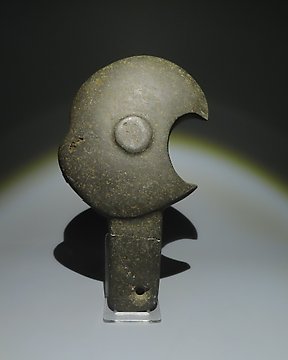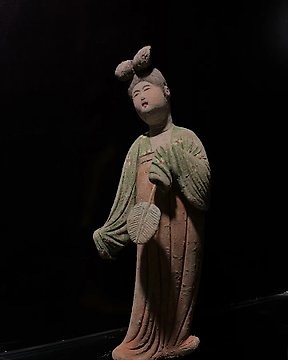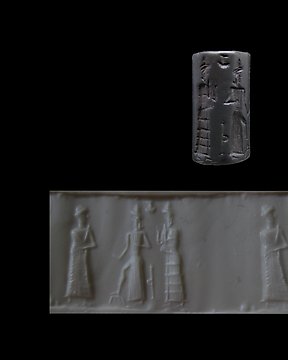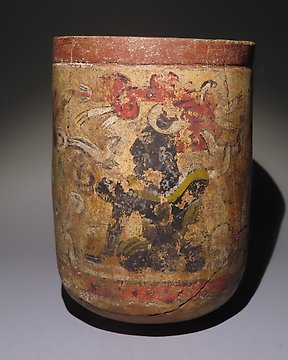BEL OBJET ANCIEN DE QUALITE BIEN EMBALLE ET ACHEMINE
查看翻译古埃及 石头 圣甲虫女神哈索尔。高 1.5 厘米。品质最佳。原件。安东诺维奇收藏品。
编号 85409493


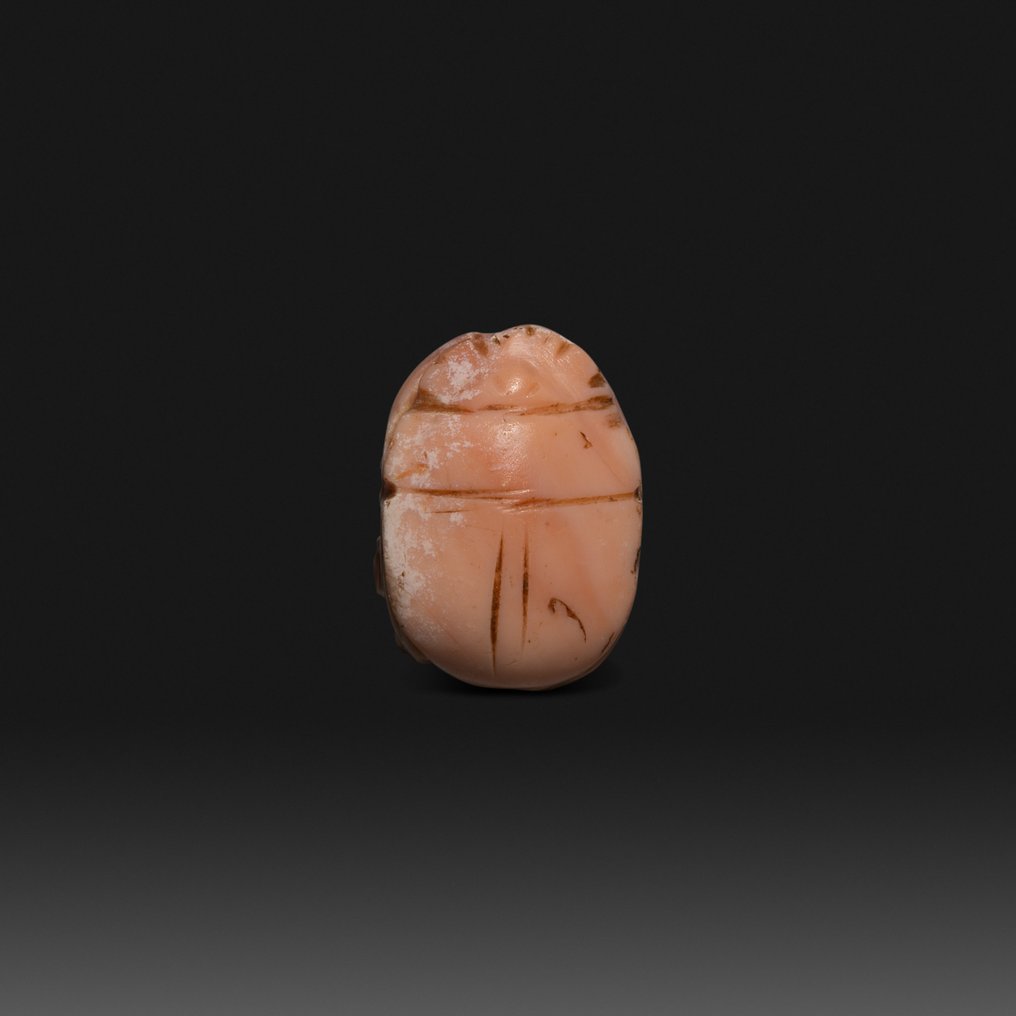
SCARAB WITH THE GODDESS HATHOR
- nice quality -
Ancient Egypt, Late Period, 664 - 323 B.C.
Stone
Height 1.5 cm
CONDITION: Intact.
PROVENANCE: Private collection, François Antonovich, Paris, France. Sold by judicial auction in 2022.
DOCUMENTS: Provided of a certificate of authenticity and export license by the Ministry of Culture.
Scarab-shaped amulet, called scarab, carved in carnelian. The upper part represents the animal in a naturalistic way, with the elytra differentiated and the head and legs reflected in detail. The scarab is placed on a flat base, decorated by incision and sunken relief with the image of the goddess Hathor identified by her characteristic headdress with cow horns. The deity appears seated in profile to the left with his torso facing forward, on a throne with a low back, in front of a vertical plant element. The image is framed by a simple oval line. The scarab is perforated longitudinally, which would allow it to be held with a cord or attached to a ring.
The scarab, a scarab-shaped amulet, is the most widespread form of Egyptian amulets both in the funerary context and in daily life. The oldest found, made of ivory, dates from the VI dynasty (c. 2345-2171 BC). The scarabs were represented in various materials: soapstone, basalt, granite and in precious stones such as lapis lazuli, amethyst, carnelian, and even in metals such as gold. In this case, in green jasper. They are generally small and pierced to allow them to be attached to a necklace, and at the base they carry a brief inscription or mythological, human or animal figures.
Symbol of the cycle of constant transformation of life, the scarab was linked to the god Jepri, form of Ra as the rising sun. The Egyptians believed that Jepri transported the Sun every day after its disappearance on the horizon, through the underground world or Duat, to make it reborn again the next day. The scarab was therefore an amulet of life and power, a representation of the rising Sun and a fundamental symbol of protection. Its importance has determined that numerous examples reach our days, which have allowed it to be studied in depth. In life, the scarab provided protection against visible and invisible evil, and daily granted strength and power to its possessor. In death, it granted the possibility of resurrection in the Afterlife and achieving eternal life.
In this funeral context, the so-called heart scarab stands out, which was placed on the chest of the deceased to protect his heart and even replace this organ if it was damaged in the mummification process. Used from the Middle Kingdom onwards, it soon became one of the most important amulets in the mummification process and funerary rituals. Starting at the end of the New Kingdom, when the heart scarab reached its greatest popularity, it began to be represented with wings, which symbolize the protection it offers. Other smaller scarabs were used in life individually or in groups, inserted in a pectoral collar structure, with the same protective function although not necessarily of a funerary type. These small scarabs also appear very frequently in rings of solar symbology, linked to the god Ra. On the other hand, a multitude of them have been found with the names of pharaohs inscribed on their base, often linked to the funerary temples of the characters they allude to but also used as protective amulets, which invoked the power of deified deceased pharaohs.
The use of amulets has been documented in Egypt as early as the Predynastic period, in the Badarian Neolithic culture (c. 4400-3800 BC). Inscribed lists have been found such as that of the Temple of Dendera or that of the so-called McGregor papyrus, where some 75 different models of amulets are cited with their form, function, meaning and signifier. They were symbolic objects that gave their possessor protection or power in the face of the world of chaos and in the journey to the Beyond. Through the word - key in ancient Egyptian culture - and appropriate rituals, the amulets were imbued with magical powers that gave them their protective function; They were therefore subjected to a kind of act of consecration that gave an inanimate object divine characteristics.
Notes:
- The piece includes authenticity certificate.
- The piece includes Spanish Export License (Passport for European Union) - If the piece is destined outside the European Union a substitution of the export permit should be requested, can take between 1-2 weeks maximum.
- The seller guarantees that he acquired this piece according to all national and international laws related to the ownership of cultural property. Provenance statement seen by Catawiki.
#alienscollection
卖家故事
SCARAB WITH THE GODDESS HATHOR
- nice quality -
Ancient Egypt, Late Period, 664 - 323 B.C.
Stone
Height 1.5 cm
CONDITION: Intact.
PROVENANCE: Private collection, François Antonovich, Paris, France. Sold by judicial auction in 2022.
DOCUMENTS: Provided of a certificate of authenticity and export license by the Ministry of Culture.
Scarab-shaped amulet, called scarab, carved in carnelian. The upper part represents the animal in a naturalistic way, with the elytra differentiated and the head and legs reflected in detail. The scarab is placed on a flat base, decorated by incision and sunken relief with the image of the goddess Hathor identified by her characteristic headdress with cow horns. The deity appears seated in profile to the left with his torso facing forward, on a throne with a low back, in front of a vertical plant element. The image is framed by a simple oval line. The scarab is perforated longitudinally, which would allow it to be held with a cord or attached to a ring.
The scarab, a scarab-shaped amulet, is the most widespread form of Egyptian amulets both in the funerary context and in daily life. The oldest found, made of ivory, dates from the VI dynasty (c. 2345-2171 BC). The scarabs were represented in various materials: soapstone, basalt, granite and in precious stones such as lapis lazuli, amethyst, carnelian, and even in metals such as gold. In this case, in green jasper. They are generally small and pierced to allow them to be attached to a necklace, and at the base they carry a brief inscription or mythological, human or animal figures.
Symbol of the cycle of constant transformation of life, the scarab was linked to the god Jepri, form of Ra as the rising sun. The Egyptians believed that Jepri transported the Sun every day after its disappearance on the horizon, through the underground world or Duat, to make it reborn again the next day. The scarab was therefore an amulet of life and power, a representation of the rising Sun and a fundamental symbol of protection. Its importance has determined that numerous examples reach our days, which have allowed it to be studied in depth. In life, the scarab provided protection against visible and invisible evil, and daily granted strength and power to its possessor. In death, it granted the possibility of resurrection in the Afterlife and achieving eternal life.
In this funeral context, the so-called heart scarab stands out, which was placed on the chest of the deceased to protect his heart and even replace this organ if it was damaged in the mummification process. Used from the Middle Kingdom onwards, it soon became one of the most important amulets in the mummification process and funerary rituals. Starting at the end of the New Kingdom, when the heart scarab reached its greatest popularity, it began to be represented with wings, which symbolize the protection it offers. Other smaller scarabs were used in life individually or in groups, inserted in a pectoral collar structure, with the same protective function although not necessarily of a funerary type. These small scarabs also appear very frequently in rings of solar symbology, linked to the god Ra. On the other hand, a multitude of them have been found with the names of pharaohs inscribed on their base, often linked to the funerary temples of the characters they allude to but also used as protective amulets, which invoked the power of deified deceased pharaohs.
The use of amulets has been documented in Egypt as early as the Predynastic period, in the Badarian Neolithic culture (c. 4400-3800 BC). Inscribed lists have been found such as that of the Temple of Dendera or that of the so-called McGregor papyrus, where some 75 different models of amulets are cited with their form, function, meaning and signifier. They were symbolic objects that gave their possessor protection or power in the face of the world of chaos and in the journey to the Beyond. Through the word - key in ancient Egyptian culture - and appropriate rituals, the amulets were imbued with magical powers that gave them their protective function; They were therefore subjected to a kind of act of consecration that gave an inanimate object divine characteristics.
Notes:
- The piece includes authenticity certificate.
- The piece includes Spanish Export License (Passport for European Union) - If the piece is destined outside the European Union a substitution of the export permit should be requested, can take between 1-2 weeks maximum.
- The seller guarantees that he acquired this piece according to all national and international laws related to the ownership of cultural property. Provenance statement seen by Catawiki.
#alienscollection
卖家故事
- 746
- 7
- 0
Todo correcto. Gracias
查看翻译Très beaux objets!!! Livraison rapide et soignée. Meeci👏🏻
查看翻译Top vendeur
查看翻译El objeto tenia algunos problemas que fueron solucionados por la empresa, labor excelente y pocas veces vista en este tipo de transacciones. Mis felicitaciones a la empresa
查看翻译Fast delivery, object fine. However, bad carrier: please never use again DHL express as they are "DHL slow": instead of coming to my address, they put it directly to a DHL Service Point/Locker.
查看翻译Todo correcto
查看翻译I am very happy with the ancient bronze horse. Excellent that it was delivered within a few days. My compliments to J.Bagot Arqueologia- Ancient Art, well done! Ron van Schaick
查看翻译Perfect transaction and fantastic item. Thank you.
查看翻译conforme rapide hope other thanks ++++
查看翻译Különleges eszköz, jó állapotban van, köszönöm a rendkívül gyors szállítást. Ajánlom az Eladót!
查看翻译fast delivery, good packaging
查看翻译Good seller: fast shipment, good packing and a very nice object. Thank you!
查看翻译super 💯💯💯💯💯
查看翻译Il pezzo è arrivato in condizioni perfette il pacco era protetto alla perfezione
查看翻译Buenos días, señor. ¡Gracias por las precauciones de embalaje Tip / Top! Muy contento con mi compra. ¡Gracias!
查看翻译Perfecto! :)
查看翻译Wunderbares Stück. Alles wie beschrieben. Hervorragender Kontakt.
查看翻译Extremely rapid courrier service from Barcelona to Flanders, picture was nicely and carefully packaged. Muchas gracias!
查看翻译Very fine specimen! Thanks.
查看翻译Top
查看翻译goede foto's, goede omschrijving, goed verpakt en snel verzonden.
查看翻译molto bello tutto ok
查看翻译Pezzo come da descrizione, davvero notevole. Venditore molto consigliato in quanto gentile e disponibile. spedizione molto veloce. Ottimo!
查看翻译Venditore davvero ottimo e gentile. Merce come da descrizione, spedizione veloce. Ottimo l'avere certificato di autenticità.
查看翻译免责声明
卖家保证并能证明该物品是合法获取的。 Catawiki 通知卖家,他们必须提供其居住国法律法规所要求的文件。 卖家保证并有权出售/出口此物品。 卖家将向买家提供有关该物品的所有已知的原产地信息。 卖家确保已经/将安排任何必要的许可。 卖家将立即通知买家有关获得此类许可可能产生的任何延误。
卖家保证并能证明该物品是合法获取的。 Catawiki 通知卖家,他们必须提供其居住国法律法规所要求的文件。 卖家保证并有权出售/出口此物品。 卖家将向买家提供有关该物品的所有已知的原产地信息。 卖家确保已经/将安排任何必要的许可。 卖家将立即通知买家有关获得此类许可可能产生的任何延误。
